Influence of Bio-Mos®, a mannan oligosaccharide supplement, on the immune system of the mare and neonatal foal
Published: May 18, 2007
By: EDGAR A. OTT - University of Florida (Courtesy of Alltech Inc.)
The neonatal foal is born immunocompetent. The foal can produce antibodies at birth and can respond to vaccines as early as 2 weeks of age, however the foal has a naive immune system. Cell-mediated immune responses are immature, and serum has few antibodies.
This is because the mare’s placenta does not allow transfer of antibodies in utero. The foal must therefore rely on the dam’s colostrum for antibodies to provide passive immunity until its immune system can produce them.
Diarrhea is the result of one of the earliest challenges the foal encounters. Foal heat diarrhea occurs at 7 to 12 days of age and is the most common type of diarrhea in foals (Cohen, 1997). This diarrhea causes minimal stress for the foal, is usually self-limiting and requires little or no medical treatment. Diarrhea that occurs just after birth or at later ages is usually pathogenic in nature and is a major health concern. Without adequate antibodies, the digestive system of the foal is vulnerable to a number of organisms including: Clostridium perfrigens (East et al., 2000), C. difficili (Jones et al., 1988), Salmonella typhimurium and other Salmonella spp. (Spier, 1993), Ehrlichia risticii and rotavirus (Dwyer, 1993; Powell et al., 1997). These organisms can establish themselves in the digestive tract of the foal resulting in diarrhea, sepsis, and even death.
Colostrum is manufactured in the mammary gland during the last two weeks of gestation and secreted the first time the foal nurses (McCue, 1993). Colostrum will contain 1500 to 5000 mg IgG/dL, 500 to 1500 mg IgA/dL and 100 to 350 mg IgM/dL (Tizard, 1996).
The dam’s colostrum is the foal’s sole source of antibodies. Those antibodies can only be absorbed during the first 24 hrs of the foal’s life. It is therefore important that the foal consume an adequate quantity of antibody-rich colostrum as soon after birth as possible.
Successful passive transfer is considered to have occurred if the foal has greater than 800 mg Ig/dL serum. Less than 200 mg Ig/dL is considered failure and 200 to 400 mg Ig/dL is partial transfer. The causes of inadequate passive immunity include: 1) low colostrum Ig concentrations, 2) inadequate colostrum intake and 3) poor Ig absorption. Failure of passive transfer (FPT) of colostrum Ig may be due to: 1) poor immune function in the mare, 2) poor transfer of serum Ig to the colostrum, 3) pre-parturition lactation (McCue, 1993), and 4) age of the mare. Mares >12 years of age (Clabough et al., 1991) and mares >15 years of age (LeBlanc et al., 1992), have been reported to have greater incidence of FPT.
There are two procedures available to help the foal obtain protection from pathogenic challenges. First, to provide colostrum with greater Ig concentrations and ensure the foal adequate opportunity to consume that colostrum. Second, to protect the foal from pathogens via intestinal environment. This report will address both procedures.
Mannan oligosaccharide supplementation
INFLUENCE ON THE IMMUNE SYSTEM
Mannans found in cell walls of S. cerevisiae have been shown to induce an antigenic response in humans (Young et al., 1998). It would therefore be logical that a mannan-based oligosaccharide might be useful in stimulating the immune system of animals (Ferket et al., 2002). Male turkeys fed 0.11% Bio-Mos® (a yeast cell wall-derived mannan oligosaccharide supplement from Alltech Inc.) for 53 days had increased blood and bile IgG and IgA concentrations (Savage et al., 1996).
Broiler breeders fed Bio-Mos® had increased maternal antibody response to infectious bursal disease virus and also maternal antibody titers in the progeny (Shashidhara and Devegowda, 2003). Sows supplemented with 5 g Bio-Mos® daily for 14 days pre-farrowing and continuing throughout lactation had significantly higher serum IgM and colostrum IgM concentrations and numerically higher colostrum IgG concentrations than unsupplemented sows (Newman and Newman, 2001).
In another study, sows treated with Bio-Mos® had higher pre-suckle colostrum IgA, IgG and IgM (O’Quinn et al., 2001). Piglets from the Bio-Mos®-treated sows were heavier at birth and at weaning. Dairy cows treated with 10 mg Bio-Mos®/day had calves that had numerically higher serum Ig levels 24-hr post-calving than calves from untreated cows (Franklin et al., 2002).
INFLUENCE ON THE INTESTINAL ENVIRONMENT
Carbohydrates, including mannose, are important surface entities on animal cells. Mannose-specific lectins are utilized by many gastrointestinal pathogens as a means of attachment to the gut epithelium (Mirelman and Ofek, 1986). One method of preventing, minimizing or breaking the attachment of these organisms to the gut wall is to provide an abundance of material that will bind to their attachment sites. E. coli with mannosespecific lectins did not attach to mammalian cells when supplemental mannose was present (Salit and Gotschlich, 1977). The addition of mannose to a tissue culture with E. coli attached to cells efficiently removed the E. coli attachment (Ofek and Beachey, 1978).
Mannose oligosaccharide has been shown to reduce colonization of a number of pathogens in poultry (Oyofo et al., 1989a,b; Spring, 1997; Spring et al., 2000) and decreased Clostridium concentrations in dogs and poultry (Finucane et al., 1999; Strickling, 1999).
The effect of Bio-Mos® on the immune function of mare and foal
Two experiments were conducted to determine whether daily supplementation with the Bio-Mos® mannan oligosaccharide would have a positive effect on the immune function of the mare and whether she could pass that advantage on to her foal.
EXPERIMENT 1: EFFECTS OF RIBOSE AND BIOMOS® SUPPLEMENTATION OF MARE DIETS
Twenty-one Thoroughbred and Quarter Horse mares were blocked by expected foaling date and assigned at random to one of three treatment groups. The control group received bahiagrass pasture and/or coastal bermudagrass hay to appetite and a concentrate formulated to provide NRC (1989) recommended levels of nutrients when fed the specified forages (Table 1).
The concentrate was fed at 0.75 kg/100 kg BW daily from -56 days to -28 days, 1.0 kg/100 kg BW daily from -28 to foaling, 1.5 kg/100 kg BW daily from foaling to +84 days and 1.0 kg/100 kg BW daily from +84 to +112 days. Concentrate feeding levels were adjusted for body condition score (Henneke et al., 1981; Ott and Asquith, 1981). The ribose-supplemented mares received the same diet plus 75 g of ribose top-dressed on the morning feeding. The Bio-Mos®-supplemented mares received the same diet plus 10 g Bio-Mos® topdressed on the morning feeding.
This is because the mare’s placenta does not allow transfer of antibodies in utero. The foal must therefore rely on the dam’s colostrum for antibodies to provide passive immunity until its immune system can produce them.
Diarrhea is the result of one of the earliest challenges the foal encounters. Foal heat diarrhea occurs at 7 to 12 days of age and is the most common type of diarrhea in foals (Cohen, 1997). This diarrhea causes minimal stress for the foal, is usually self-limiting and requires little or no medical treatment. Diarrhea that occurs just after birth or at later ages is usually pathogenic in nature and is a major health concern. Without adequate antibodies, the digestive system of the foal is vulnerable to a number of organisms including: Clostridium perfrigens (East et al., 2000), C. difficili (Jones et al., 1988), Salmonella typhimurium and other Salmonella spp. (Spier, 1993), Ehrlichia risticii and rotavirus (Dwyer, 1993; Powell et al., 1997). These organisms can establish themselves in the digestive tract of the foal resulting in diarrhea, sepsis, and even death.
Colostrum is manufactured in the mammary gland during the last two weeks of gestation and secreted the first time the foal nurses (McCue, 1993). Colostrum will contain 1500 to 5000 mg IgG/dL, 500 to 1500 mg IgA/dL and 100 to 350 mg IgM/dL (Tizard, 1996).
The dam’s colostrum is the foal’s sole source of antibodies. Those antibodies can only be absorbed during the first 24 hrs of the foal’s life. It is therefore important that the foal consume an adequate quantity of antibody-rich colostrum as soon after birth as possible.
Successful passive transfer is considered to have occurred if the foal has greater than 800 mg Ig/dL serum. Less than 200 mg Ig/dL is considered failure and 200 to 400 mg Ig/dL is partial transfer. The causes of inadequate passive immunity include: 1) low colostrum Ig concentrations, 2) inadequate colostrum intake and 3) poor Ig absorption. Failure of passive transfer (FPT) of colostrum Ig may be due to: 1) poor immune function in the mare, 2) poor transfer of serum Ig to the colostrum, 3) pre-parturition lactation (McCue, 1993), and 4) age of the mare. Mares >12 years of age (Clabough et al., 1991) and mares >15 years of age (LeBlanc et al., 1992), have been reported to have greater incidence of FPT.
There are two procedures available to help the foal obtain protection from pathogenic challenges. First, to provide colostrum with greater Ig concentrations and ensure the foal adequate opportunity to consume that colostrum. Second, to protect the foal from pathogens via intestinal environment. This report will address both procedures.
Mannan oligosaccharide supplementation
INFLUENCE ON THE IMMUNE SYSTEM
Mannans found in cell walls of S. cerevisiae have been shown to induce an antigenic response in humans (Young et al., 1998). It would therefore be logical that a mannan-based oligosaccharide might be useful in stimulating the immune system of animals (Ferket et al., 2002). Male turkeys fed 0.11% Bio-Mos® (a yeast cell wall-derived mannan oligosaccharide supplement from Alltech Inc.) for 53 days had increased blood and bile IgG and IgA concentrations (Savage et al., 1996).
Broiler breeders fed Bio-Mos® had increased maternal antibody response to infectious bursal disease virus and also maternal antibody titers in the progeny (Shashidhara and Devegowda, 2003). Sows supplemented with 5 g Bio-Mos® daily for 14 days pre-farrowing and continuing throughout lactation had significantly higher serum IgM and colostrum IgM concentrations and numerically higher colostrum IgG concentrations than unsupplemented sows (Newman and Newman, 2001).
In another study, sows treated with Bio-Mos® had higher pre-suckle colostrum IgA, IgG and IgM (O’Quinn et al., 2001). Piglets from the Bio-Mos®-treated sows were heavier at birth and at weaning. Dairy cows treated with 10 mg Bio-Mos®/day had calves that had numerically higher serum Ig levels 24-hr post-calving than calves from untreated cows (Franklin et al., 2002).
INFLUENCE ON THE INTESTINAL ENVIRONMENT
Carbohydrates, including mannose, are important surface entities on animal cells. Mannose-specific lectins are utilized by many gastrointestinal pathogens as a means of attachment to the gut epithelium (Mirelman and Ofek, 1986). One method of preventing, minimizing or breaking the attachment of these organisms to the gut wall is to provide an abundance of material that will bind to their attachment sites. E. coli with mannosespecific lectins did not attach to mammalian cells when supplemental mannose was present (Salit and Gotschlich, 1977). The addition of mannose to a tissue culture with E. coli attached to cells efficiently removed the E. coli attachment (Ofek and Beachey, 1978).
Mannose oligosaccharide has been shown to reduce colonization of a number of pathogens in poultry (Oyofo et al., 1989a,b; Spring, 1997; Spring et al., 2000) and decreased Clostridium concentrations in dogs and poultry (Finucane et al., 1999; Strickling, 1999).
The effect of Bio-Mos® on the immune function of mare and foal
Two experiments were conducted to determine whether daily supplementation with the Bio-Mos® mannan oligosaccharide would have a positive effect on the immune function of the mare and whether she could pass that advantage on to her foal.
EXPERIMENT 1: EFFECTS OF RIBOSE AND BIOMOS® SUPPLEMENTATION OF MARE DIETS
Twenty-one Thoroughbred and Quarter Horse mares were blocked by expected foaling date and assigned at random to one of three treatment groups. The control group received bahiagrass pasture and/or coastal bermudagrass hay to appetite and a concentrate formulated to provide NRC (1989) recommended levels of nutrients when fed the specified forages (Table 1).
The concentrate was fed at 0.75 kg/100 kg BW daily from -56 days to -28 days, 1.0 kg/100 kg BW daily from -28 to foaling, 1.5 kg/100 kg BW daily from foaling to +84 days and 1.0 kg/100 kg BW daily from +84 to +112 days. Concentrate feeding levels were adjusted for body condition score (Henneke et al., 1981; Ott and Asquith, 1981). The ribose-supplemented mares received the same diet plus 75 g of ribose top-dressed on the morning feeding. The Bio-Mos®-supplemented mares received the same diet plus 10 g Bio-Mos® topdressed on the morning feeding.
| Table 1.Formulation and nutrient content of the concentrate fed to the mares and foals. |
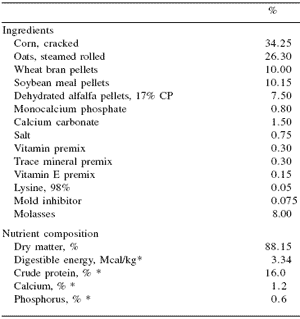 |
| *Dry matter basis |
Mares were weighed, measured for heart girth and given a condition score at the start of the experiment and at 28-day intervals until weaning at 112 days postparturition.
Blood samples were collected from the mares at -28, 0 (foaling), +28, and +56 days. Colostrum was collected from the mares within 6 hrs of parturition and milk samples collected at day three. Foals were weighed, measured for withers height, heart girth, body length and hip height at birth and at 28 day intervals to weaning. Fecal scores were assigned to each foal daily to assess the gastrointestinal health status of the foal.
Blood from both mares and foals, colostrum and milk were analyzed for IgG, IgA, and IgM.
Results
Two mares aborted prior to their due dates and all data from these mares were excluded from the record. A third mare had a septic foal that died shortly after birth. Her data were also excluded. Weights and condition scores of the mares are shown in Table 2. There were no differences in weight or condition score between treatment groups. The foals from the Bio-Mos®-treated mares were smaller than foals from the other two groups at birth and they did not catch up by the end of the experiment (Table 3).
Serum IgG, IgA and IgM values for the mares were not influenced by diet (Table 4). Although mares on the Bio-Mos® treatment had higher colostrum IgA values and tended to have numerically higher IgG and IgM values than the other two groups, those differences were present at the start of the experiment and may not have been due to treatment. Several mares started dripping milk prior to parturition (11 hr to 12 days). It was determined that the colostrum collected from these mares after parturition was considerably lower in IgG than colostrum from mares that did not leak milk and their foals were provided with supplemental colostrum.
| Table 2. Weights and condition scores of mares fed supplemental ribose and Bio-Mos®. |
 |
| Table 3.Influence of ribose and Bio-Mos® on weights and measurements of suckling foals. |
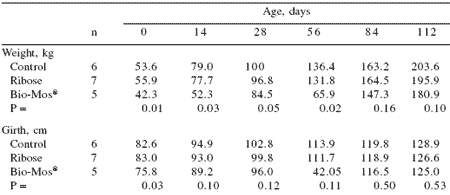 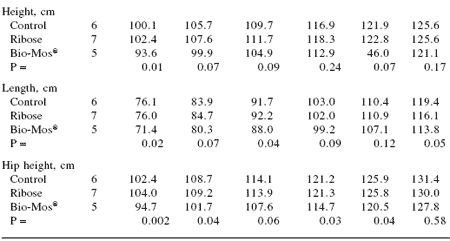 |
| Table 4.Serum and colostrum IgG, IgA and IgM concentrations for mares fed ribose and Bio-Mos® (Means + SE). |
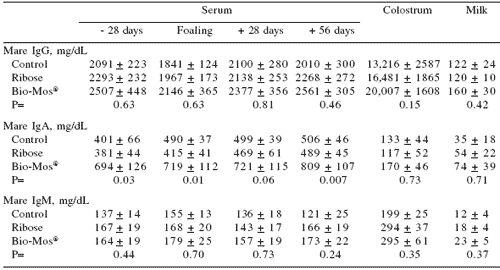 |
Although we intended to collect colostrum samples within 3 hrs of parturition, this was not always accomplished. There was a negative correlation between time after parturition that the colostrum was collected and the IgG content. Colostrum collected during the first 2 hrs post-partum had a mean IgG concentration of 17,483 + 1309, during the next hour it decreased to 13,643 + 1,879, and at 10 to 12 hrs post-partum it decreased to 1,474 + 654. For the purpose of evaluating the diets, only animals from which the colostrum was collected during the first 3 hrs post-parturition and which did not leak milk prior to parturition were used.
Foal serum IgG and IgA values were not different between groups but IgM values were higher for the foals from mares supplemented with Bio-Mos® (P = 0.0392) on day 0 (Table 5). IgG values gradually decreased to 56 days with the Bio-Mos® foals having a numerical advantage throughout the study. Fecal scores on the foals revealed that some of the foals exhibited diarrhea at about 56 days of age. In all cases the diarrhea was treated successfully and the foals recovered. There was more diarrhea in the Control foals that the other two groups. Five of the six Control foals exhibited diarrhea sufficiently severe to require treatment (Table 6). Three of the foals from the ribose-treated mares and none of the foals from the Bio-Mos® treated mares exhibited severe diarrhea (P = 0.021). The data suggest that the Bio-Mos® supplementation may have caused the mares to secrete additional antibodies in the colostrum and that the foals receiving these antibodies were better able to cope with the microbial challenges to the digestive system. An alternative or additional explanation may be that the foals from the Bio-Mos® mares consumed Bio-Mos® from the dam’s feed tub and received a direct benefit of lowered gut pathogen susceptibility.
Table 5. Serum IgG, IgA and IgM concentrations from foals from mares fed ribose and Bio-Mos® (Means + SE). |
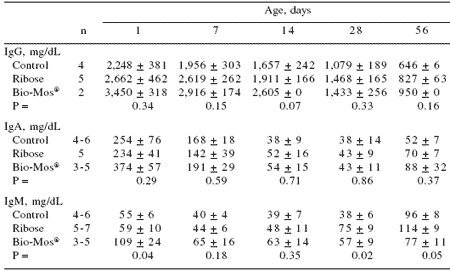 |
| Table 6. Influence of Bio-Mos® and ribose supplementation of mares on incidence of diarrhea in their foals. |
 |
| 1Only diarrhea severe enough to justify treatment. Chi-square = 0.021 |
EXPERIMENT 2: MARE AND FOAL RESPONSE TO BIO-MOS® SUPPLEMENTATION OF MARE DIETS
Twenty-six Thoroughbred and Quarter Horse mares were paired by expected foaling dates and assigned at random to one of two treatment groups. The control mares were fed a concentrate (Table 1) that was formulated to provide NRC (1989) recommended concentrations of nutrients when fed with bahiagrass (Paspalum notatum) pasture or Coastal bermudagrass (Cynodon dactylon) hay. The mares were individually fed concentrate twice daily and received 0.75 kg concentrate/100 kg BW daily from -56 to -28 days, 1.0 kg concentrate/100 kg BW daily from -28 days to parturition, 1.5 kg concentrate/100 kg BW daily from parturition to +84 days and 1.0 kg concentrate/100 kg BW daily from +84 to weaning at +112 days.
Concentrate intake was adjusted according to the body condition of the mare. The hay was fed to appetite until adequate spring pasture was available. Corn meal (placebo) was top-dressed on the morning concentrate at 50 g/day. The treatment group was fed the same diet with 10 g Bio-Mos® and 40 g corn meal top-dressed on the morning feed. Foals were allowed to eat with their dams in the stall and also received the dam’s concentrate in a creep feeder in the pasture.
Mares were weighed and a condition score assigned at the start of the experiment and at 28 day intervals throughout the experiment. Foals were weighed and measured for withers height, heart girth, body length and hip height at birth and on days 7, 14, 28, 56 and 112. Blood samples were collected from the mares on days -56, 0, and +28. Colostrum samples were collected before the foal nursed and milk samples collected on day 3. Blood samples were collected from the foal before the foal nursed, 6 - 10 hr post-partum (8 hr sample), and on days 7, 14, 28, 56,and 112.
Results
Mares maintained normal body weight and condition scores. There were no differences (P>0.05) between diet groups. Foals in both diet groups had similar birth weights and grew at similar rates throughout the experiment (Table 7). Mare serum IgG, IgA, and IgM concentrations were not influenced by diet (Table 8). Colostrum IgG concentrations were higher (Table 9) in the mares fed Bio-Mos® (P = 0.03). Colostrum IgA
concentrations were higher in the mares fed Bio-Mos® (P = 0.008). Colostrum IgM values were numerically higher in the mares fed Bio-Mos® (P = 0.08). Foal serum IgG, concentrations increased from less than 100 mg/ dL at birth to over 1400 mg/dL at 8 hrs and gradually declined throughout the experiment (Table 10). There were no differences between diet groups (P>0.05). Foal serum did not have any detectable IgA at birth but increased to over 200 mg/dL at 8 hrs. IgA values decreased to 14 days of age and gradually increased to weaning. No differences due to diet were detected (P>0.05). Foal serum IgM values were less than 20 mg/dL at birth and gradually increased throughout the experiment. No dietary differences were detected (P>0.05).
| Table 7. Influence of diet on foal growth and development (LS Means + SE). |
 |
Discussion
Data on humans (Young et al., 1998), poultry (Savage et al., 1996; Shashidhara and Devegowda, 2003), swine (Newman and Newman, 2001), dairy cattle (Franklin et al., 2002), suggest that mannan oligosaccharide in the form of Bio-Mos® can have a positive effect on the immune status of the animal. Data on the effect of this material on equines was non-existent until these two experiments were conducted. In the first experiment, pregnant mares were supplemented with either ribose or Bio-Mos® from 56 days before expected parturition until 84 days post-partum. Neither supplement influenced the weight or condition of the mares.
The foals from the Bio-Mos® supplemented mares were smaller than foals from the other two groups and that difference continued through out the experiment. Mare serum IgG and IgM concentrations were not influenced by the diets, but IgA values were higher in the Bio- Mos®-fed mares. Colostrum IgG and IgA values were numerically higher in the Bio-Mos®-treated mares. Their foals did not have higher serum IgG and IgA concentrations but were higher in IgM values on day 1. There did seem to be a positive effect of the Bio-Mos® on foal diarrhea.
In the second experiment, there was no difference in foal birth weight between the control and the Bio-Mos®- fed mares and growth of the two groups of foals was not different. There was no detectable difference in mare serum IgG, IgA and IgM concentrations. Colostrum IgG and IgA values were higher in the Bio-Mos®-treated mares but this did not transfer to foal serum concentrations. There was no diarrhea detected in any of these foals.
Although the data from these two experiments do not provide overwhelming evidence that Bio-Mos® will have a positive effect on the immune status of mares and their foals, they do provide evidence that under certain conditions Bio-Mos® will improve the immune function in the horse and will help foals cope with pathogenic challenges to the digestive system.
| Table 8.Influence of Bio-Mos® on mare serum Ig concentrations (means + SE). |
 Y Y |
| Table 9.Influence of Bio-Mos® on colostrum Ig concentrations (means + SE). |
 |
| Table 10. Influence of Bio-Mos® on foal serum Ig concentrations (means + SE). |
 |
References
Clabough, D.L., J.F. Levine, G.G. Grant and H.S. Conboy. 1991. Factors associated with failure of passive transfer of colostral antibodies in Standardbred foals. J. Vet. Intern. Med. 5:335-340.
Cohen, N.D. 1997. Diarrheal diseases of foals. In: Current Therapy in Equine Medicine. (N.E. Robinson, ed). W.B. Saunders Co., Philadelphia, PA, USA, pp. 631-636.
Dwyer, R.M. 1993. Rotaviral diarrhea. Vet. Clin. N. Amer. Equine Pract. 9:311-319.
East, L.M., D.A. Dargatz, J.L. Traub-Dargatz and C.J. Savage. 2000. Foaling-management practices associated with the occurrence of enterocolitis attributed to Clostridium perfringens infection in equine neonate. Prev. Vet. Med. 46:61-74.
Ferket, P.R., C.W. Parks and J.L. Grimes. 2002. Benefits of dietary antibiotic and mannanoligosaccharide supplementation for poultry. Proc. Multi-State Poult. Mtg. Indianapolis, IN, USA, May 14-16.
Finucane, M.C., K.A. Dawson, P. Spring and K.E. Newman. 1999. The effect of mannanoligosaccharide on the composition of the microflora in turkey poults. Poult. Sci. 78(Suppl. 1):77.
Franklin, S.T., K.E. Newman and M.C. Newman. 2002. Evaluation of mannan oligosaccharide on the immune status of dairy cows and their calves. J. Anim. Sci. 80(Suppl 1):192.
Henneke, D.R., G.D. Potter and J.L. Kreider. 1981. A condition score relationship to body fat content of mares during gestation and lactation. Proc. 7th Equine Nutr. Phy. Symp., p. 105.
Jones, R.L., R.K. Shideler and G.L. Cockerell. 1988. Association of Clostridium difficile with foal diarrhea. Equine Infect. Dis. V. Proc. 5th Intl. Conf., pp. 236- 240.
LeBlanc, M.M., T. Tran, J.L. Baldwin and E.L. Pritchard. 1992. Factors that influence the passive transfer of immunoglobulins in foals. JAVMA 200:179-183.
McCue, P.M. 1993. Lactation. In: Equine Reproduction (A.O. McKinnon and J.L. Voss, eds). Lea & Febiger, Philadelphia, PA, USA, pp. 588-595.
Mirelman, D. and I. Ofek. 1986. Introduction to microbial lectins and agglutinin. In: Microbial Lectins and Agglutins-Properties and Biological Activity (D. Mirelman, ed). John Wiley and Sons, Inc., NY, USA, p. 1.
Newman, K.E. and M.C. Newman. 2001. Evaluation of mannan oligosaccharide on the microflora and immunoglobulin status of sows and piglet performance. J. Anim. Sci. 79:189
Ott, E.A. and R.L. Asquith. 1981. Vitamin and mineral supplementation of foaling mares. Proc. 7th Equine Nutr. Phy. Symp., p. 44.
Ofec, I. and E.H. Beachey. 1978. Mannose binding and epitheal cell adherence of Escherichia coli. Infect. Immun. 22:247-254.
O’Quinn, P.R., D.W. Funderburke and G.W. Tibbetts. 2001. Effects of dietary supplementation with mannan ligosaccharides on sow and litter performance in a commercial production system. J. Anim. Sci. 79:212.
Oyofo, B.A., R.E. Droleskey, J.O. Norman, H.H. Mollenhauer, R.L. Ziprin, D.E. Corrier and J.R. DeLoach. 1989a. Inhibition by mannose of in vitro colonization of chicken small intestine by Salmonella typhimurium. Poult. Sci. 68:1351-1356.
Oyofo, B.A. J.R. Deloach, D.E. Corrier, J.O. Norman, R.L. Ziprin and H.H. Mollenhauer. 1989b. Prevention of Salmonella typhimurium colonization of broilers with D-mannose. Poult. Sci. 68:1357-1360.
Powell, D.G., R.M. Dwyer, J.L. Traub-Dargatz, R. H. Fulker, J.W. Walen, Jr., J. Srinivasappa, E.M. Acree and H.J. Chu. 1997. Field study of the safety, immunogenicity and efficacy of an inactive equine rotovirus vaccine. J. Am. Vet. Med. Assoc. 211:193- 198.
Salit, I.E. and E.C. Gotschlich. 1977. Type I Escherichia coli pili: characterization of binding to monkey kidney cells. J. Exp. Med. 146:1182-1194.
Savage, T.F., P.F. Cotter and E.I. Zakrzewska. 1996. The effect of feeding a mannanoligosaccharide on immunoglobulins, plasma IgA and bile IgA of Wrolstad MW male turkeys. Poult. Sci. 75(Suppl. 1):143.
Shashidhara, R.G. and G. Devegowda. 2003. Effect of dietary mannan oligosaccharide on breeder production traits and immunity. Poult. Sci. 82:1319-1325. Spier, S.J. 1993. Salmonellosis. Vet. Clin. N. Amer. Equine Pract. 9:385-397.
Spring, P. 1997. Effects of mannan oligosaccharide on different cecal parameters and on cecal concentrations of enteric pathogens in poultry. PhD Dissertation. Swiss Fed. Inst. of Tech.
Spring, P., C. Wenk, K.A. Dawson and K.E. Newman. 2000. The effects of mannan oligosaccharide on cecal parameters and the concentrations of enteric bacteria in the ceca of Salmonella- challenged broiler chicks. Poult. Sci. 79:205-211.
Strickling, J.A. 1999. Evaluation of oligosaccharide addition to dog diets: influence on nutrient digestion and microbial populations. Masters Thesis. University of Kentucky, Lexington, KY, USA. Tizard, I.R. 1996. Veterinary Immunology: An Introduction. W.B. Saunders Co., Philadelphia, PA, USA.
Young, M., M.J. Davies, D. Bradley, M.J. Gradwell, B. Smestad-Paulsen, J.K. Wold, R.M.R. Barnes and E.F. Hounsell. 1998. Characterization of oligosaccharides from an antigenic mannan of Saccharomyces cerevisiae. Glycoc. J. 15:815-822.
Author: EDGAR A. OTT
Professor Emeritus, Department of Animal Sciences, University of Florida, Gainesville, Florida, USA
Related topics:
Recommend
Comment
Share

Would you like to discuss another topic? Create a new post to engage with experts in the community.